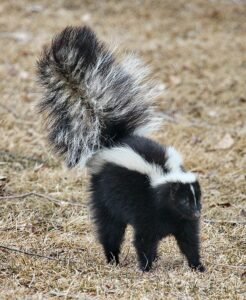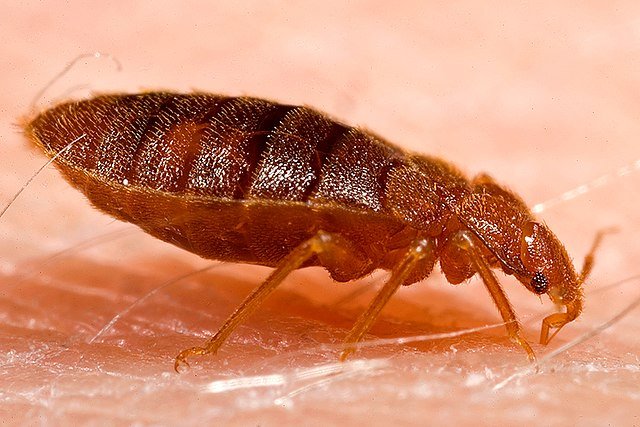Skunks (Mephitis mephitis): Identification, Risks, and Control
 Skunks (Mephitidae) are some of the most recognizable mammals in North America, best known for their ability to spray a foul-smelling liquid as a defense mechanism. The striped skunk (Mephitis mephitis) in particular is widespread, living comfortably in forests, grasslands, suburbs, and even urban centers.
Skunks (Mephitidae) are some of the most recognizable mammals in North America, best known for their ability to spray a foul-smelling liquid as a defense mechanism. The striped skunk (Mephitis mephitis) in particular is widespread, living comfortably in forests, grasslands, suburbs, and even urban centers.
Although their black-and-white markings give them a distinctive appearance, skunks are more than just a nuisance with an odor. They play ecological roles as insect predators, seed dispersers, and scavengers. At the same time, their digging habits, burrowing under structures, and potential to carry diseases such as rabies make them a concern for homeowners, farmers, and public health officials.
This guide provides a comprehensive look at skunks: how to identify them, their biology and behavior, where they live, the risks they pose, how to manage infestations, and the cultural perceptions that surround them.
Identification
Scientific name: Mephitis mephitis (striped skunk, the most common species).
Family: Mephitidae, which includes striped skunks, spotted skunks, hog-nosed skunks, and hooded skunks.
Size: Adults range from 40–70 cm (16–28 inches) in length, including tail. Weight varies from 1.5–4.5 kg (3–10 pounds).
Appearance: Glossy black fur with distinctive white stripes running from the head down the back and tail. Stripes may vary in thickness.
Tail: Long and bushy, often raised when threatened.
Behavioral trait: When alarmed, skunks raise their tail, stamp their feet, and, if necessary, spray sulfur-based chemicals from anal scent glands.
Skunks are sometimes confused with other small, dark mammals like raccoons (Procyon lotor) or opossums (Didelphis virginiana), but their striking black-and-white markings make them relatively easy to distinguish.
Biology and Ecology
Diet
Skunks are omnivores and highly opportunistic feeders. Their diet includes:
Insects such as beetles, crickets, and grasshoppers.
Small rodents.
Birds’ eggs and hatchlings.
Fruits and berries.
Human garbage and pet food.
By eating insects like grubs and even Fruit flies (Drosophila spp.), skunks provide some natural pest control.
Reproduction
Breeding season occurs in late winter (February–March).
Females give birth in May or June to litters of 4–7 kits.
Kits stay with the mother until fall and often disperse before winter.
Lifespan
In the wild, most skunks live 2–4 years. In captivity, they may survive up to a decade.
Behavior
Nocturnal: Active mainly at night.
Solitary: Except during mating season and when raising young.
Burrowing: Skunks dig dens under decks, sheds, woodpiles, or natural shelters.
Global Distribution
Skunks are native to North and Central America. The striped skunk (Mephitis mephitis) has the widest distribution, covering nearly all of the United States, southern Canada, and northern Mexico.
Other species include:
Eastern spotted skunk (Spilogale putorius) – Southeastern and central U.S.
Hooded skunk (Mephitis macroura) – Southwestern U.S., Mexico, and Central America.
Hog-nosed skunk (Conepatus leuconotus) – Found in Texas, New Mexico, Arizona, and further south.
Skunks have also been introduced into some regions outside their native range, but they are not globally invasive like Pigeons (Columba livia) or European starlings (Sturnus vulgaris).
Risks and Damage
Although skunks are not aggressive, their presence around homes and farms can cause issues:
Odor
The sulfur-based spray can travel up to 3–5 meters (10–15 feet) and cause nausea, temporary blindness, and lingering odor that clings to surfaces. Pets often get sprayed after confronting skunks.
Property damage
Digging up lawns in search of grubs.
Burrowing under porches, sheds, and decks, which can weaken foundations.
Raiding chicken coops for eggs and chicks.
Disease transmission
Skunks are recognized rabies vectors in North America. They may also carry leptospirosis, distemper, and parasites such as fleas and ticks. These parasites can also transfer to other animals or humans, similar to those carried by Blow flies (Calliphoridae) in different contexts.
Agricultural impact
Skunks may damage corn by eating developing kernels and raid bee hives for larvae.
Signs of Infestation
Odor: Strong, lingering smell around property, especially at night.
Tracks: Skunk tracks show five toes on both front and hind feet, with visible claw marks.
Droppings: Small, tube-shaped droppings containing insect parts.
Burrows: Openings near sheds, decks, or woodpiles.
Pet encounters: Dogs and cats returning home sprayed.
Control Methods
Prevention
Secure garbage cans with tight lids.
Bring pet food indoors at night.
Protect poultry with strong wire enclosures.
Remove brush piles, woodpiles, and clutter where skunks may build dens.
Physical barriers
Install skunk-proof fencing (buried at least 30 cm deep to prevent digging).
Seal off spaces under porches and decks.
Repellents
Commercial repellents based on ammonia, citrus, or predator urine may deter skunks, but effectiveness is mixed.
Trapping
Live traps can be used where legal, baited with cat food or sardines.
Handle with caution—trapped skunks are likely to spray.
Relocation laws vary by state or country.
Advanced Approaches
Professional pest control
Licensed professionals can safely trap and remove skunks, especially in urban areas where human-wildlife conflict is high.
Integrated pest management (IPM)
Combines exclusion, sanitation, habitat modification, and, if needed, trapping. Similar methods are used for managing other urban wildlife like Raccoons (Procyon lotor) and Squirrels (Sciurus spp.).
Odor neutralization
Enzymatic cleaners and peroxide-baking soda solutions can neutralize spray odor. This is critical for homeowners and especially veterinarians treating sprayed pets.
Cultural and Historical Context
Skunks have played diverse roles in human culture:
Indigenous traditions: Some Native American tribes viewed skunks with respect for their defensive power, while others used skunk oil in medicine.
Folklore: Skunks often symbolize caution, defense, or avoidance.
Modern culture: Popular characters like Pepé Le Pew (Looney Tunes) have made skunks iconic, albeit stereotyped.
In ecology, skunks are valued for controlling insect populations and rodents. Yet in human settlements, their defensive spray overshadows their beneficial roles.
FAQ
Q1: Do skunks always spray when threatened?
No. Spraying is a last resort. Skunks usually give warning signals such as stamping feet and raising tails.
Q2: How far can skunks spray?
Up to 5 meters (15 feet), with accuracy of about 2 meters (6 feet).
Q3: Are skunks dangerous to humans?
They are not aggressive but can transmit rabies. The odor from spraying is unpleasant but not life-threatening.
Q4: What should I do if my pet gets sprayed?
A solution of hydrogen peroxide, baking soda, and dish soap works better than tomato juice. Commercial skunk odor removers are also available.
Q5: Can skunks climb fences?
They are poor climbers but excellent diggers. That’s why fencing must extend underground.
Q6: Do skunks hibernate?
Not true hibernation, but they become less active in winter and may share dens for warmth.
Final Thoughts
Skunks (Mephitis mephitis and related species in the family Mephitidae) are remarkable animals, balancing ecological value with significant nuisance potential. They consume insects, rodents, and fallen fruit, making them important pest managers in natural ecosystems. Yet, when they enter urban and suburban landscapes, their odor, digging, and disease risks make them problematic for people and pets.
Effective skunk control requires a combination of exclusion, sanitation, and—when necessary—professional assistance. Understanding their biology and behavior helps homeowners anticipate problems, while respecting their role in the food web. By approaching skunks with both caution and knowledge, communities can reduce conflict while maintaining balance with local wildlife.
Disclaimer
Disclaimer
This article is for informational purposes only. Pest control laws and approved wildlife-handling practices vary by country and region. For best results and legal safety, we strongly recommend contacting a licensed wildlife or pest control professional in your local area. Always ensure that any professional is properly certified or licensed, depending on your country’s regulations. It is important to confirm that only approved methods are used, and that they are applied exactly as instructed by local authorities or product labels. In most regions across North America and Europe, following label directions and legal guidelines is not just best practice—it’s the law.
Author Bio
Nasos Iliopoulos
MSc Agronomist & Certified Pest Control Expert
Scientific Director – Advance Services (Athens, Greece)
Licensed Pest Control Business – Ministry of Rural Development & Food (GR)
References
Wikipedia – Skunks
Britannica – Skunk (Mephitidae)

